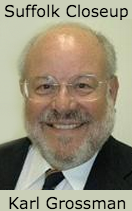The Economic Opportunity Council of Suffolk, launched in the 1960s as the key organization in Suffolk County to engage in what was then called the War on Poverty, remains alive and well. And it’s still a leader in Suffolk in not  only dealing with poverty, a continuing serious problem in the county, but now with a myriad of other economic and social problems as well.
only dealing with poverty, a continuing serious problem in the county, but now with a myriad of other economic and social problems as well.
As it describes itself on its website, EOC is “Suffolk County’s designated community action agency, recipient of the Federal Community Service Block Grant, which supports activities designed to assist low-income families and individuals… Our mission is to promote a goal of self-sufficiency by broadening the minds of children, revitalizing communities, and assisting families and children in need through the provision of services and to coordinate available federal, state, local and private resources.”
Of poverty in Suffolk, Adrian Fassett, president and chief executive officer of EOC—he started at one of its Head Start programs in 1987—says there “is plenty of poverty in this county. The needs of individuals have changed from earlier days. The face of poverty has changed.”
“There are more working poor now then there were in the past,” Fassett says.
“For instance, in the 1960s housing was not an issue. Somehow people could find housing. But now housing is a major issue because of its cost.” Rent is sky-high, and the cost to purchase a house unaffordable for many, many people.
Fassett cited a study that concludes that it now takes an income of $90,000 for “a family of three to live comfortably on Long Island.” And if one parent is working at a fast-food outlet, another at a big-box store, they might be making a combined income of $40,000, he said.
As to subsidized housing, people are routinely on waiting lists for government-supported Section 8 housing for three and four years. “In some communities it’s longer than that,” he said.
Another change concerns war veterans. In the 1960s when soldiers returned from Vietnam they might get “spit upon” by war opponents. Now soldiers come back from Afghanistan and Iraq after “doing so many tours. We have veterans who have done three or four tours. They come back a mess.” And, he said, “Suffolk County has the highest concentration of returning veterans” of any county in the state. Some battered vets live here in primitive “encampments,” many in tents.
For people struggling to find housing in Suffolk’s hyper-expensive housing market, EOC offers an array of programs in conjunction with the federal Department of Housing and Community Development. This includes a “First Home Club” that provides down-payment assistance, bi-weekly clinics providing housing counsel and legal advice in partnership with the New York Legal Assistance Group, and a “Mortgage Default and Foreclosure Prevention Program.”
For damaged returning vets, EOC has a “Supportive Services for Veteran Families Program” that includes housing and support services for veterans and their families. This program, its website notes, features “Income Support Services, Personal Financial Planning, Vocational and Rehabilitation Services through the New York State Department of Labor, Employment Training Assistance through the Suffolk County One-Stop Employment Center…Peer Support/Outreach Services through Suffolk County United Veterans, Assistance obtaining VA and other Public Benefits though Suffolk County Veterans Service Agency.”
These are just some of the many programs of EOC of Suffolk. It has an annual budget of $14 million, 38 percent federal funds, the rest state, county and private. The breadth of its programs—from one end of the county to another—is astounding. It has 176 full-time staff members.
Other EOC programs, all detailed on its website, include “Services for People with Development Disabilities,” “Chronic Health Care Coordination,” “HIV/AIDS Targeted Prevention and Support Services,” “SNUG Violence Protection,” “Suffolk County Family Court Children’s Nursery,” even “Montauk Child Care.”
On Riverhead and the North Fork, EOC’s Riverhead Family Development Center is located at 633 East Main Street and its Greenport Family Development Center is at 421 Front Street. It is based in Patchogue.
Paul Arfin, long-time social worker and author of the book “Unfinished Business: Social Action In Suburbia: Long Island NY 1945-2014,” published last year, says of EOC of Suffolk: “Its success and survival for five decades is due to the ongoing commitment of its board of directors, executive leadership and local community action agencies to identify, train and inspire low-income people to represent the poor and underserved. Its success is testimony to the organization’s fulfillment of the basic mission of the War on Poverty—maximum participation of those served. EOC of Suffolk has successfully overcome public resistance to the very idea that poverty exists in the county. Its leaders have also persevered as advocates to educate elected and appointed officials on a bi-partisan level. Its success can also be seen in its ability, in a highly-competitive and changing environment, to create a strong infrastructure and policies and procedures that change with the times.”
The survival of local journalism depends on your support.
We are a small family-owned operation. You rely on us to stay informed, and we depend on you to make our work possible. Just a few dollars can help us continue to bring this important service to our community.
Support RiverheadLOCAL today.
































